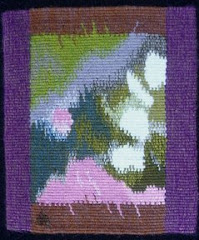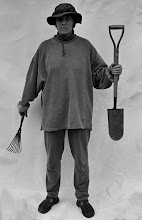Unfortunately, it was closed for renovations for 2 years. This time my luck has changed and it is reopened, with a gorgeous museum, and an amazing permanent exhibition.
 Although it’s not very far away from where we are staying, it took
2 trains and 2 busses to get to this elegant museum on a green hill in Riggisberg, in the
canton of Bern.
Although it’s not very far away from where we are staying, it took
2 trains and 2 busses to get to this elegant museum on a green hill in Riggisberg, in the
canton of Bern.
Swiss born Werner Abegg began collecting early: goldsmithing,
sculpture, painting, ceramics and intaglio, as well as antique Egyptian
tapestries, medieval silk fabrics and 18th Century “bizarre”
silks. He and his American wife,
Margaret, spent part of each year in NY, and later collected Pre-Columbian
Peruvian textiles. The Abeggs donated their collections to the foundation in
the early 1960s.
Since Werner's death in 1984, the foundation has continued to add
textiles to the collection. The foundation is primarily a research institute, which publishes scholarly treatises, and has a textile conservation workshop, which offers a degree course in Textile
Conservation and Restoration.
Because photography is prohibited, I
purchased a number of postcards, and a very informative book:
The first item in the book, and the oldest, is a
double-headed Hacilar vessel from what is now southwestern Turkey, from the 6th
millennium BC.
I also loved a small
bronze statue of Horus the falcon, from Egypt. Being familiar with a larger one
at the MFA in Boston, it was like running into an old friend. I was charmed with the manner of his display, as he was standing there looking wistfully out the window....an unusual stance in a museum, but so appropriate for a bird who was considered the God of the Sky.
A piece that many textile people would "ooh" and "aah" over is
the 3D Cross-knit looped decorative trim from Peru, 1st-3rd Century AD. The colors are still bright, and the hummingbirds and flowers
intact.
Dionysus, (Egypt, 4th C, linen and wool) is 210 cm high and 700
cm wide (after reconstruction: the fragments are stitched to a background fabric). It shows 8 figures standing under decorated
arches, including Dionysus and his love, Ariadne.
 It is very finely woven, and most of the colors are still bright. It
was found buried in sand in the Egyptian desert. You can see an image of it, from a distance, in this excellent article from Hali (along with a detail of the next item).
It is very finely woven, and most of the colors are still bright. It
was found buried in sand in the Egyptian desert. You can see an image of it, from a distance, in this excellent article from Hali (along with a detail of the next item).
 It is very finely woven, and most of the colors are still bright. It
was found buried in sand in the Egyptian desert. You can see an image of it, from a distance, in this excellent article from Hali (along with a detail of the next item).
It is very finely woven, and most of the colors are still bright. It
was found buried in sand in the Egyptian desert. You can see an image of it, from a distance, in this excellent article from Hali (along with a detail of the next item).
(LEFT: Dionysus detail)
I was surprised and delighted by a large tapestry of winged horses,
(Egypt, 4th-5th C) because of its still vibrant red wool warp, which matched the background weft. Parts of this tapestry are a bright
white, which made me wonder if those areas could be cotton. Bright white wool is very hard to come by, and often yellows with time....but wouldn't cotton have rotted? A mystery...
There is a case with 8 exquisite small tapestry fragments, from
clothing. One fragment from a neckline trim (Egypt, 3rd-4th century), is only 20 cm high,
by 31 cm wide, yet it includes images of hunters with weapons, flowers, lions.
This piece has lost all of the red wool background weft, possibly due to
substances in the red dye, but the delicacy of the images is still evident.
“Spring and Summer,” (Egypt, 3rd-4th C, about 10x10” each, wool) is two pieces from a set of 4 small tapestries of the
seasons, very finely woven. Click on the link for a photo.
 (LEFT: Elijah, detail)
(LEFT: Elijah, detail)
A large hanging titled Elijah (linen and wool, Egypt, 4th - 6th C, 309 x 344
cm) is like nothing I have seen before. It shows scenes from the Old Testament,
all rendered in brightly colored, coarse wool, looped pile on a natural linen background.
 This large fragment of a skirt (Central Asia, 3rd-1st
century BC, Wool, 51cm x 102.5 cm) is bright red fabric top and bottom, with a tapestry
border of stylized animals between. The catalog says that it “ appears to
originate from a small independent pastoral culture that can be only very
loosely associated with other known Eurasian steppe cultures.”
This large fragment of a skirt (Central Asia, 3rd-1st
century BC, Wool, 51cm x 102.5 cm) is bright red fabric top and bottom, with a tapestry
border of stylized animals between. The catalog says that it “ appears to
originate from a small independent pastoral culture that can be only very
loosely associated with other known Eurasian steppe cultures.”
In addition to the impressive collection, the way it is displayed could not be better. The obvious attention to detail in every aspect of this museum is astonishing. It may be inconvenient, but it should be on all your lists of places you hope to visit someday.
NOTE: Click on an image to see it larger
NOTE: Click on an image to see it larger



